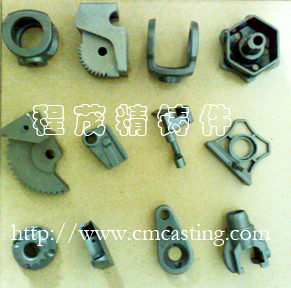1. Casting can also be divided into gravity casting and pressure casting according to the pouring process of molten metal. Gravity casting refers to the process of injecting molten metal into a mold under the action of the earth's gravity, also called casting. Gravity casting in a broad sense includes sand casting, metal casting, investment casting, mud casting, etc.; gravity casting in a narrow sense refers specifically to metal casting. Pressure casting refers to the process of injecting molten metal into the mold under the action of other external forces (excluding gravity). Die casting in a broad sense includes pressure casting and vacuum casting of die casting machines, low pressure casting, centrifugal casting, etc.; pressure casting in a narrow sense refers to metal die casting of die casting machines, referred to as die casting.Dongguan Precision CastingChengmao Hardware ProductsLimited companyHas long been engaged in the gravity casting of sand and metal molds. These casting processes are currently the most commonly used in non-ferrous metal casting and the lowest relative price.

2. Sand casting is a traditional casting process that uses sand as the main modeling material to make molds. The sand mold generally adopts gravity casting. When there are special requirements, low-pressure casting, centrifugal casting and other processes can also be used. Sand casting has a wide range of adaptability, small pieces, large pieces, simple pieces, complex pieces, single pieces, and large quantities can be used. The molds used for sand casting were mostly made of wood in the past, commonly known as wooden molds. Chengmao Hardware Products Co., Ltd., in order to change the defects such as easy deformation and easy damage of wooden molds, except for the single-piece sand castings, all changed to aluminum alloy molds or resin molds with higher dimensional accuracy and longer service life. Although the price has increased, it is still much cheaper than the mold for metal casting. In the production of small batches and large parts, the price advantage is particularly prominent. In addition, sand molds have higher refractoriness than metal molds, so materials with higher melting points such as copper alloys and ferrous metals also use this process. However, sand casting also has some shortcomings: because each sand mold can only be poured once, the mold is damaged after the casting is obtained and must be reshaped, so the production efficiency of sand casting is low; and because the overall nature of sand is soft However, it is porous, so the dimensional accuracy of sand casting castings is lower, and the surface is rougher. but,Cheng Mao Hardware Products Co., Ltd.With many years of technical accumulation, the surface condition of sand castings has been greatly improved, and the effect after shot blasting is comparable to that of metal castings.
3. Metal mold casting is a modern technology for making hollow casting molds for casting with heat-resistant alloy steel. The metal mold can be either gravity casting or pressure casting. The metal mold can be used repeatedly, and every time the molten metal is poured, a casting is obtained, which has a long life and high production efficiency. Metal castings not only have good dimensional accuracy and smooth surface, but also have higher strength than sand castings and are less likely to be damaged when the same molten metal is poured. Therefore, in the mass production of medium and small non-ferrous metal castings, as long as the melting point of the casting material is not too high, metal casting is generally preferred. However, metal mold casting also has some shortcomings: because heat-resistant alloy steel and the processing of making hollow cavities on it are relatively expensive, the cost of metal molds is expensive, but the overall cost of die casting molds is cheaper. too much. For small batch production, the mold cost allocated to each product is obviously too high, which is generally not easy to accept. And because the metal mold is limited by the size of the mold material, the cavity processing equipment, and the capacity of the casting equipment, it is also powerless for particularly large castings. Therefore, metal mold casting is rarely used in the production of small batches and large parts. In addition, although the metal mold adopts heat-resistant alloy steel, its heat-resistant ability is still limited. Generally, it is mostly used for casting of aluminum alloy, zinc alloy, and magnesium alloy. It has been less used in copper alloy casting, but is used for ferrous metal casting. It's even less.Cheng Mao Hardware Products Co., Ltd.All of the metal molds are designed and manufactured by ourselves, so we can provide customers with cheap and suitable high-quality molds in a timely manner.
Related News
- Precision casting mirror treatment and dewaxing casting
- Controlling the high quality of precision cast steel is the key
- Production Development of Guangdong Stainless Steel Casting Alloy Steel
- Characteristics of precision cast steel investment casting
- Dongguan precision casting kitchen hardware pendant varieties
- Processing steps and cleaning methods of Guangdong stainless steel castings
- Definition of Guangdong carbon steel casting
- Classification of Dongguan Precision Casting Special Casting
- Dongguan Precision Casting Factory
- What are the types of alloy steel casting hardware in Guangdong
- Overview of dewaxing casting
- Dongguan Precision Casting
- Process material of stainless steel precision casting
- What are the factors that cause the formation of stainless steel casting pores?
- The relationship between Guangdong stainless steel casting technology and Guangdong steel casting technology
- Regarding the difference between precision casting, casting, die casting, and forging
- What are the points to pay attention to when choosing stainless steel parts for robots?
- Heat treatment process of precision casting
- How can I be competent for Dongguan precision casting castings?
- Do you know what aspects of the precision casting process can be harmed?
